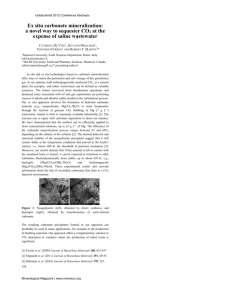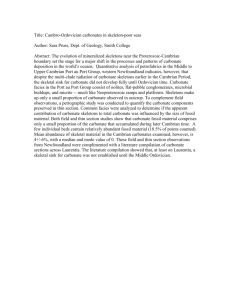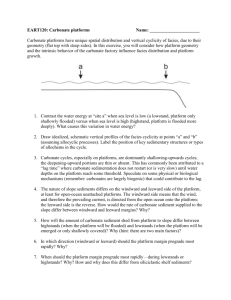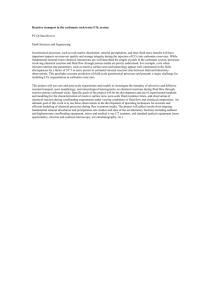Complexity in Carbonates - School of GeoSciences
advertisement
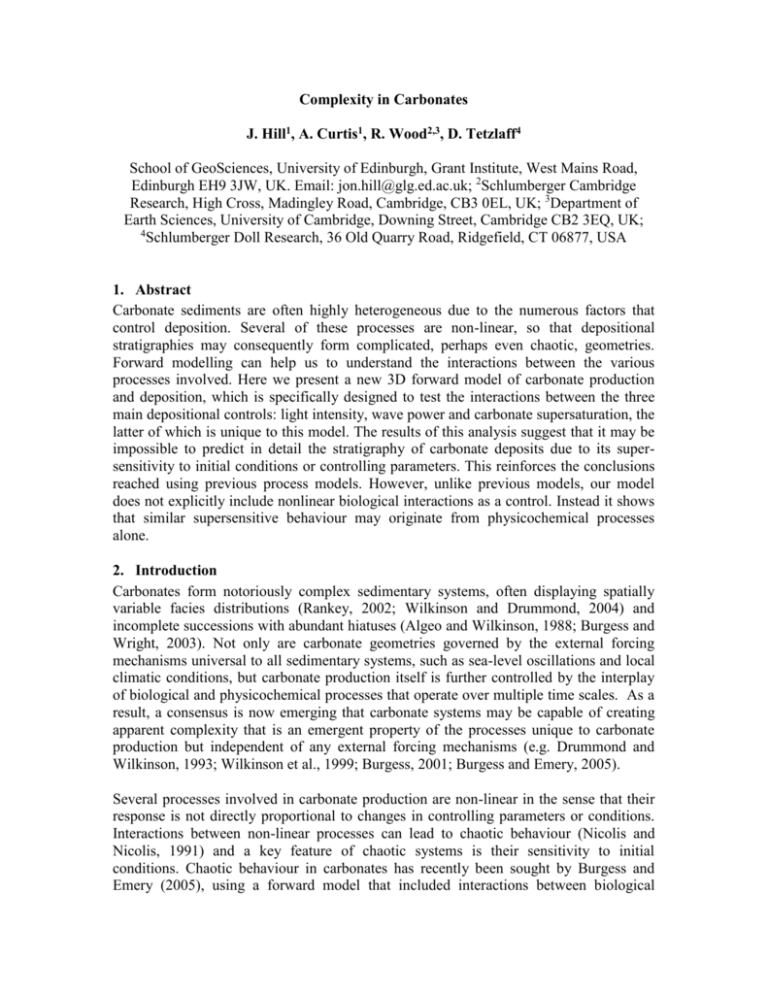
Complexity in Carbonates J. Hill1, A. Curtis1, R. Wood2,3, D. Tetzlaff4 School of GeoSciences, University of Edinburgh, Grant Institute, West Mains Road, Edinburgh EH9 3JW, UK. Email: jon.hill@glg.ed.ac.uk; 2Schlumberger Cambridge Research, High Cross, Madingley Road, Cambridge, CB3 0EL, UK; 3Department of Earth Sciences, University of Cambridge, Downing Street, Cambridge CB2 3EQ, UK; 4 Schlumberger Doll Research, 36 Old Quarry Road, Ridgefield, CT 06877, USA 1. Abstract Carbonate sediments are often highly heterogeneous due to the numerous factors that control deposition. Several of these processes are non-linear, so that depositional stratigraphies may consequently form complicated, perhaps even chaotic, geometries. Forward modelling can help us to understand the interactions between the various processes involved. Here we present a new 3D forward model of carbonate production and deposition, which is specifically designed to test the interactions between the three main depositional controls: light intensity, wave power and carbonate supersaturation, the latter of which is unique to this model. The results of this analysis suggest that it may be impossible to predict in detail the stratigraphy of carbonate deposits due to its supersensitivity to initial conditions or controlling parameters. This reinforces the conclusions reached using previous process models. However, unlike previous models, our model does not explicitly include nonlinear biological interactions as a control. Instead it shows that similar supersensitive behaviour may originate from physicochemical processes alone. 2. Introduction Carbonates form notoriously complex sedimentary systems, often displaying spatially variable facies distributions (Rankey, 2002; Wilkinson and Drummond, 2004) and incomplete successions with abundant hiatuses (Algeo and Wilkinson, 1988; Burgess and Wright, 2003). Not only are carbonate geometries governed by the external forcing mechanisms universal to all sedimentary systems, such as sea-level oscillations and local climatic conditions, but carbonate production itself is further controlled by the interplay of biological and physicochemical processes that operate over multiple time scales. As a result, a consensus is now emerging that carbonate systems may be capable of creating apparent complexity that is an emergent property of the processes unique to carbonate production but independent of any external forcing mechanisms (e.g. Drummond and Wilkinson, 1993; Wilkinson et al., 1999; Burgess, 2001; Burgess and Emery, 2005). Several processes involved in carbonate production are non-linear in the sense that their response is not directly proportional to changes in controlling parameters or conditions. Interactions between non-linear processes can lead to chaotic behaviour (Nicolis and Nicolis, 1991) and a key feature of chaotic systems is their sensitivity to initial conditions. Chaotic behaviour in carbonates has recently been sought by Burgess and Emery (2005), using a forward model that included interactions between biological communities. They found that, although complicated, the water depth changes at a single point through time were not chaotically dependent on initial conditions. Their model produced cyclical, quasiperiodic shallowing upwards stratigraphy, without any sea level oscillations, clearly demonstrating the non-linear effect of internal controls on carbonate production. However, a significant component of the nonlinearity in Burgess and Emery’s model is derived from a matrix of competing biological communities with controlling parameters that are currently poorly known in carbonate systems. Below, we briefly describe the model used here and then show the results from two cases where the starting topography differed by only one metre at one location. We demonstrate that this model is capable of generating autocycles, which show no apparent patterns in thicknesses. We then discuss whether these results suggest that carbonate deposition using the processes modelled is chaotic or merely complicated. 3. Model Rationale and Formulation The model used in this study is Carbonate GPM (Hill et al., 2005). The model contains two carbonate types; reef and non-reef, and is built upon a pre-existing siliciclastic forward model, GPM (Tetzlaff and Priddy, 2001). As such it inherits all GPM’s features, such as erosion, wave action, fault action, compaction and fluctuating sea levels. The model uses the rationale of several other forward models (e.g. Bosscher and Southam, 1992; Burgess, 2001; Warrlich et al., 2002) by using a maximum carbonate production rate and reducing this according to the local environmental parameters at each point in space, x, and time. The production rate is calculated using: P( x, c) S L ( L, c) S (, c) SW (W , c) Pm (c) (1) where each S is an individual stress functions (Fig. 1.) that define the production efficiency decrease due to varying controlling environmental factors relative to the maximum production rate, Pm (m/yr), x is a vector of orthogonal horizontal coordinates (x,y), c is the carbonate type (reef or non-reef), and P is the production rate (m/yr) at each location. Controlling factors on which the stress functions depend are light availability (L), carbonate supersaturation () and wave energy (W), with the individual stress functions, SL, S and SW. The effect of supersaturation is calculated via residence time, which is the time taken for a parcel of water to traverse any given space (Demicco and Hardie, 2002). A. C. B. 1 0 0 0.2 0.4 SL 0.6 0.8 1 1 0.9 5 0.8 10 Water Depth (m) 0.8 0.7 S 0.6 SW 0.6 0.5 0.4 0.4 0.3 20 25 30 35 0.2 0.2 40 0.1 0 0 15 50 100 150 Residence Time (days) 200 250 0 0 45 500 1000 1500 2000 Wave Power (W/m2) 2500 3000 50 Fig. 1. The three stress functions used by Carbonate GPM due to A. supersaturation, S, B. wave power, SW, and C. light intensity, SL. 4. Results from Model Experiments The experiment carried out is based on that described in detail by Burgess and Emery (2005). Two model runs were produced which used identical parameters, including a relative sea level curve that included subsidence only (Fig. 2A). The only difference between the two runs is a 1 m change of topography at one node, henceforth referred to as the -node (Fig. 2B). The two runs were then run forward for 1 Myr and data were output every 5000 years, producing 200 data points in total. The timestep increment was 200 years. A. 200 B. 180 Relative Sea Level (m) 160 140 120 100 80 60 40 20 0 0 100 200 300 400 500 600 700 800 900 1000 Time (kyr) Fig. 2. A. The relative sea level used for both runs. B. The starting topographies for the two experimental runs. The node at which the topography was raised by 1m is highlighted on the right hand plot. Note that there is a 40x vertical exaggeration in order to show the 1m difference. Both runs typically show similarities in their overall final stratigraphic geometries. They start with a short period of progradation, followed by extensive aggradation as sediment is swept onshore by wave action. In each run islands are formed intermittently due to both erosion and transport of the sediment and the effect of residence time (Fig. 3). The flow slows in the vicinity of a topographic high and is refracted, producing gyres, which increase the residence time in that area (Fig. 3B). This reduces production rates, causing deepening in the lee side of the high relative to the stoss side where deposition continue at a higher rate. Eventually the deep area is filled with eroded sediment and the process repeats itself. A. B. Fig. 3. The effect of islands on the residence time. A snapshot of the Carbonate GPM output after 160 kyr with arrows showing the direction and magnitude of the wave induced flow (A). Islands can be seen in the lagoon that cause the flow to refract around them. This then causes a local high in the residence time in the lee of the islands (B). The scale in B shows the residence time in days. The statistical properties of the cycles produced by the two runs are useful to demonstrate how complicated patterns of sediment deposition can be formed from internal forcings alone. One of the most striking things about models that produce autocycles is that there is no order to the cycle thicknesses generated (Burgess and Emery, 2005). The simplest way of representing this is to plot the thickness of one cycle (n) against the thickness of the proceeding cycle (n+1). Analysing the data in this manner produced no visible patterns at any location around the reef or lagoon. The relationship between cycles can be further analysed using the Durbin-Watson test (Durbin and Watson, 1950, 1951), which tests if the null hypothesis of no correlation between adjacent values can be rejected. The cycles produced at the -node were analysed and produced a value of 2.45 (the critical value is 1.76 for an uncertainty of 0.05). This means the null hypothesis cannot be rejected and hence the cycle thickness at any one time is not dependent on the previous cycle thickness. Other cells analysed confirm this result, demonstrating that a purely deterministic model can produce apparently random cycles thicknesses based on the interactions of simple modelled processes. 5. Complicated or Chaotic? In seeking indications of chaotic behaviour, we can analyse the water depth changes at any one point through time. The first step is to create a power spectrum of the data, which will show if there is any periodicity to the system. A chaotic time series will have a spectrum with no obvious periodicities (Williams, 1997). The power spectrum of the water depth changes at the -node shows there is no dominant periodicity present in the time series (Fig. 4). This indicates that the variable measured is not the result of one or a small number of oscillations, but contains a broad range of frequencies. This behaviour in a deterministic system not forced by random inputs may be an indication of chaotic behaviour. 10 10 10 Power 10 10 10 10 10 1 0 -1 -2 -3 -4 -5 -6 0 0.01 0.02 0.03 0.04 0.05 0.06 Frequency (kyr-1) 0.07 0.08 0.09 0.1 Fig. 4. Power spectrum calculated using the water depth changes at the altered node. A second criterion for possible chaotic behaviour is to establish the system’s sensitivity to small perturbations. In chaotic systems, a small perturbation applied to the system causes its trajectory in the state space (the space of all variables that describe the system at a given time) to locally diverge exponentially relative to the original run (Kantz and Schreiber, 1997). While we have not attempted to prove this behaviour in a general way, we have tested one example for a manifestation of this property, namely extreme sensitivity to a small change in initial conditions. The water depth histories (Fig. 5A) at the -node show that the two runs have similar histories, with water depth varying between 0 and 1.5m, but they do not follow the same patterns and the depth of Run 1 is often lower than that of Run 2. Fig 5B shows the natural logarithm of the absolute difference in water depths between the two runs. This plot clearly shows that the two runs diverge quickly for 15kyr. The difference between the two runs then oscillates around a mean value. This plot shows that the evolution of the model is compatible with chaotic behaviour. A. B. 0 1 -2 Natural Log of Differences in Water Depth 1.5 Water Depth (m) 0.5 0 -0.5 -6 -8 -10 -1 -1.5 0 -4 100 200 300 400 500 600 Time (kyr) 700 800 900 1000 -12 0 Run 1 Run 2 100 200 300 400 500 600 Time (kyr) 700 800 900 1000 Fig. 5. Comparison of the water depth histories of the two runs. B. shows the log of the difference between the curves in A. 6. Discussion We have presented a numerical forward model that includes three major processes controlling carbonate production, which together with transport and erosion of deposited sediment has shown behaviour that is sensitive to initial conditions. Other carbonate models have also shown this type of behaviour (Burgess and Emery, 2005). However Carbonate GPM does not include any poorly known biological processes, instead utilising relatively well-calibrated physicochemical processes alone. The results of this work therefore suggest that such complicated stratigraphies are an inherent property of the carbonate system. Including biological activity will only increase the complexity of the stratigraphy. This raises the possibility that it may be impossible to predict the stratigraphy of carbonates in detail, instead we must rely on statistical descriptions. The effect that external controls have on the carbonate system is uncertain. They may overwhelm the internal controls used in this model and produce ordered successions, or may add further to the intricate stratigraphy generated here. 7. References Algeo, T. J., Wilkinson, B. H., 1988. Periodicity of mesoscale Phanerozoic sedimentary cycles and the role of milankovitch orbital modulation. Journal of Geology 96 (3), 313322. Bosscher, H., Southam, J., 1992. CARBPLAT - A computer model to simulate the development of carbonate platforms. Geology 20 235-238. Burgess, P. M., 2001. Modeling Carbonate sequence development without relative sealevel oscillations. Geology 29 (12), 1127-1130. Burgess, P. M., Wright, V. P., 2003. Numerical forward modelling of carbonate platform dynamics: An evolution of complexity and completeness in carbonate strata. Journal of Sedimentary Research 73 637-652. Demicco, R. V., Hardie, L. A., 2002. The "carbonate factory" revisited: A reexamination of sediment production functions used to model deposition on carbonate platforms. Journal of Sedimentary Research 72 849-857. Drummond, C. N., Wilkinson, B. H., 1993. Carbonate cycle stacking patterns and hierarchies of orbitally forced eustatic sealevel change. Journal of Sedimentary Petrology 63 (3), 369-377. Durbin, J., Watson, G. S., 1950. Testing for serial correlation in least squares regression. I. Biometrika 37 (3/4), 409-428. Durbin, J., Watson, G. S., 1951. Testing for serial correlation in least squares regression. II. Biometrika 38 (1/2), 159-177. Hill, J., Tetzlaff, D., Curtis, A., Wood, R., 2005. Modelling carbonate supersaturation. Journal of Sedimentary Research (in prep.) Kantz, H., Schreiber, T., 1997. Nonlinear Time Series Analysis, Cambridge University Press, 304pp Nicolis, G., Nicolis, C., 1991. Nonlinear dynamic systems in the geosciences. Bulletin of the Kansas Geological Survey 233 33-42. Rankey, E. C., 2002. Stratal patterns of sediment accumulation on a Holocene carbonate tidal flat. Northwest Andros Island, Bahamas. Journal of Sedimentary Research 72 591601. Warrlich, G. M. D., Waltham, D. A., Bosence, D. W. J., 2002. Quantifying the sequence stratigraphy and drowning mechanisms of atolls using a new forward modelling program (CARBONATE 3D). Basin Research 14 (3), 379-400. Wilkinson, B. H., Drummond, C. N., 2004. Facies mosaics across the Persian Gulf and around Antigua - Stochastic and deterministic products of shallow-water sediment accumulation. Journal of Sedimentary Research 74 (4), 513-526. Wilkinson, B. H., Drummond, C. N., Diedrich, N. W., Rothman, E. D., 1999. Poisson processes of carbonate accumulation on Paleozoic and Holocene platforms. Journal of Sedimentary Research 69 (2), 338-350. Williams, G. P., 1997. Chaos Theory Tamed, Taylor and Francis, 499pp



